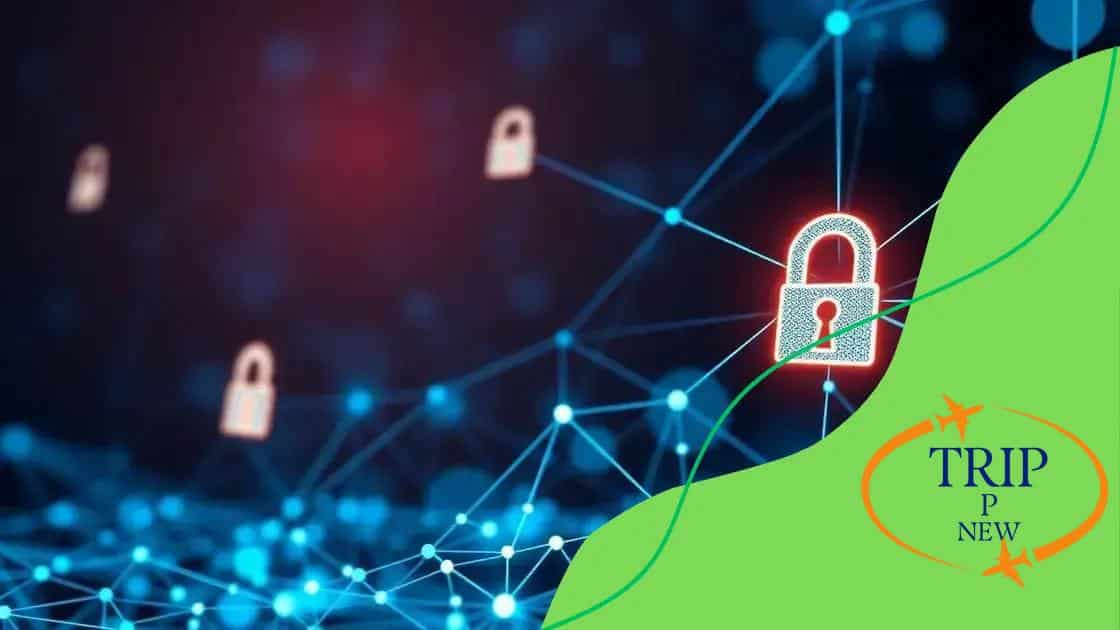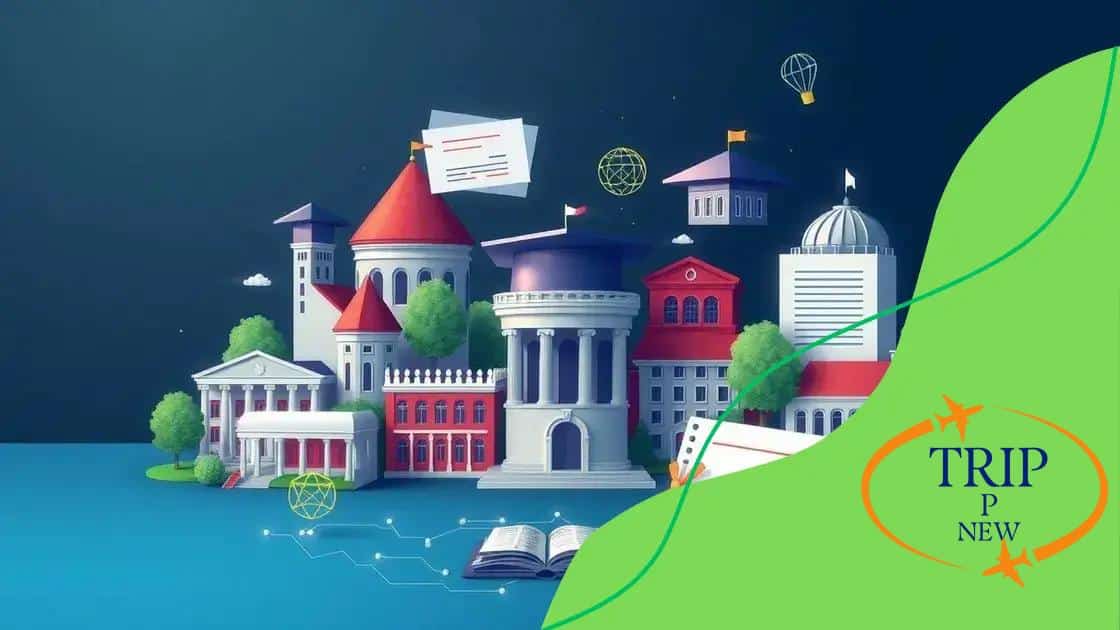Blockchain for academic record security: ensuring integrity

Anúncios
Blockchain for academic record security provides a decentralized and secure method to verify and manage academic credentials, ensuring data integrity and protecting against fraud.
Blockchain for academic record security is changing how educational institutions handle data integrity. Have you ever wondered how secure your academic records are? This article dives into the benefits of blockchain in safeguarding education.
Anúncios
Understanding blockchain technology
Understanding blockchain technology is crucial for grasping how it impacts academic record security. At its core, blockchain is a decentralized digital ledger that securely records transactions across multiple computers. This technology ensures that once data is recorded, it cannot be altered without consensus from the entire network.
Key Features of Blockchain
There are several aspects of blockchain that contribute to its effectiveness:
- Decentralization: No single entity controls the blockchain, reducing the risk of manipulation.
- Transparency: Every participant can view the entire history of transactions, fostering trust.
- Immutability: Once data is added, it cannot be changed, protecting the integrity of academic records.
- Security: Advanced cryptographic techniques keep sensitive information safe from unauthorized access.
These features make blockchain a powerful tool in the education sector. Imagine applying this technology to student records. Each achievement, from grades to diplomas, could be stored securely on a blockchain, ensuring that it remains accurate and verifiable over time.
Anúncios
How Blockchain Works
Every transaction on a blockchain is grouped into a block. These blocks are then linked together in a chain, hence the name “blockchain.” When a new transaction is initiated, it must be validated by participating nodes on the network. This consensus mechanism allows only legitimate transactions to be added to the chain.
Moreover, blockchain technology can dramatically speed up record verification processes. Instead of relying on traditional paperwork and manual checks, educational institutions can access real-time data swiftly. This eliminates delays in verifying academic credentials, making it easier for students to pursue further education or job opportunities.
Overall, understanding blockchain technology is essential for anyone interested in improving the security and efficiency of academic records. As we delve deeper into its applications, the benefits become even more apparent, showcasing how this technology is redefining education.
Why blockchain enhances record security
Why blockchain enhances record security is a vital question in today’s digital landscape. One of the most significant advantages of blockchain technology is its ability to protect sensitive information from tampering and unauthorized access. By utilizing a decentralized network, each transaction is verified and secured, creating an environment where academic records are safe.
Core Benefits of Blockchain Security
Several key factors contribute to how blockchain enhances security:
- Transparency: Each party involved can view and verify the data, which builds trust and reduces the chances of fraud.
- Consensus Mechanism: Before any changes are made, a majority of network participants must agree, ensuring that only legitimate transactions are recorded.
- Data Integrity: The chain of blocks is immutable, meaning once data is entered, it cannot be altered without consensus.
- Encryption: Advanced cryptographic techniques protect data, making it extremely difficult for hackers to access sensitive information.
This combination of features creates a robust security framework that is particularly beneficial for academic records. For instance, when students apply for jobs or further studies, employers and institutions can quickly verify credentials without the risk of fraud or error.
Real-World Applications
Many educational institutions are already exploring the use of blockchain. By storing diplomas and transcripts on a secure blockchain, schools can streamline the verification process. This helps create a secure and efficient way to handle academic records, reducing the time needed for background checks.
Moreover, users have peace of mind knowing their records are not only safe but also easily accessible. This level of security fosters a more trustworthy educational environment.
As we see more organizations adopting this technology, the importance of understanding how blockchain enhances record security becomes clear. It’s not just about protecting data; it’s about creating a more reliable system for all stakeholders involved.
Case studies of blockchain in education

Case studies of blockchain in education highlight how innovative institutions are employing this technology to enhance academic record management. Real-world applications provide valuable insights into the benefits and challenges of using blockchain in educational settings.
Successful Implementations
Several universities have already adopted blockchain for various purposes. The following examples demonstrate its potential:
- The University of Dubai: This institution uses blockchain to securely store and verify academic credentials. Students can share their records easily with employers, which streamlines the hiring process.
- MIT Media Lab: MIT has issued digital diplomas using blockchain technology, allowing graduates to prove their credentials without the need for physical documents.
- Open University of Malaysia: This progressive university has developed a system to record and verify student achievements via blockchain, ensuring data integrity and accessibility for future employers.
These case studies illustrate that universities are recognizing the value of blockchain technology. By enhancing transparency and security, they are creating a trustworthy academic environment.
Challenges Faced
Despite its promises, using blockchain in education is not without challenges. Some institutions struggle with technology adoption, while others face regulatory hurdles. Integrating blockchain with existing systems can also be complex.
However, the successful examples show that overcoming these challenges is possible. Institutions that invest in training and infrastructure can reap the benefits of this revolutionary technology.
By studying these case examples, educational organizations can better evaluate whether blockchain in education aligns with their goals and needs, making informed decisions for the future.
Challenges of implementing blockchain
Challenges of implementing blockchain in education highlight the complexities that many institutions face when adopting this technology. While blockchain offers significant benefits, the path to implementation is not straightforward.
Common Obstacles
Several hurdles can impede the successful adoption of blockchain in educational settings:
- Technological Integration: Many institutions already rely on established systems. Integrating blockchain with these legacy systems can be complicated.
- Cost of Implementation: The initial investment for blockchain technology, including software, hardware, and training, can be substantial.
- Regulatory Compliance: Educational institutions must navigate various regulations that may impact how they implement blockchain solutions.
- Lack of Understanding: There is often a knowledge gap regarding blockchain technology. Educators and administrators may need significant training to effectively utilize it.
These challenges make it essential for institutions to carefully plan their implementation strategies. Taking a phased approach can help ease the transition. By gradually integrating blockchain into existing systems, institutions can minimize disruption and build familiarity among staff.
Change Management
Managing change is crucial when adopting new technologies. Educators and administrators must be onboard for successful implementation. Involving all stakeholders in the process can help foster a supportive environment.
Institutions may also benefit from partnerships with technology companies that specialize in blockchain solutions. These partnerships can provide the necessary expertise and support, helping institutions to navigate barriers more effectively.
Despite the obstacles, understanding and addressing these challenges is key to realizing the full potential of blockchain technology in education. By approaching implementation thoughtfully, institutions can create a more secure and efficient system for managing academic records.
Future trends in academic record security
Future trends in academic record security are evolving rapidly as technology continues to advance. The integration of blockchain is just the beginning. Educational institutions are exploring new solutions to enhance the security and integrity of academic records.
Emerging Technologies
In the coming years, we can expect to see the following innovations:
- AI and Machine Learning: These technologies will help automate verification processes, making academic record checks faster and more reliable.
- Smart Contracts: Implementing smart contracts on a blockchain can further secure transactions related to academic records, reducing the risk of fraud.
- Decentralized Identity Solutions: Students may manage their academic identity securely, allowing for more control over their data.
- Increased Collaboration: Educational institutions may partner with tech companies to develop tailored blockchain solutions that cater to their specific needs.
These trends signal a shift towards a more secure and efficient academic environment. By adopting these technologies, educational institutions can ensure the ongoing trust and validity of academic records.
Focus on Data Privacy
Another significant trend is the emphasis on data privacy. As regulations like GDPR and CCPA evolve, institutions will need to prioritize protecting student information. This involves implementing stricter data protection measures and ensuring compliance with legal standards.
The future of academic record security will not only focus on technology but also on preserving student privacy and preventing unauthorized access. As educational institutions navigate these changes, they will enhance their systems significantly.
By staying informed about these trends, institutions can adapt proactively, ensuring they meet the demands of a secure academic environment.
FAQ – Frequently Asked Questions about Blockchain for Academic Record Security
What is blockchain technology?
Blockchain technology is a decentralized digital ledger that securely records transactions across multiple computers, ensuring that data cannot be altered without consensus.
How does blockchain enhance academic record security?
Blockchain enhances security by providing transparency, immutability, and advanced encryption, making it difficult for unauthorized access and fraud.
What are the challenges of implementing blockchain in education?
Challenges include integrating with existing systems, the cost of implementation, regulatory compliance, and ensuring all stakeholders understand the technology.
What future trends are expected in academic record security?
Future trends include increased adoption of artificial intelligence, decentralized identity solutions, and a greater focus on data privacy and regulatory compliance.





